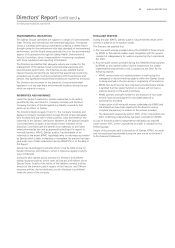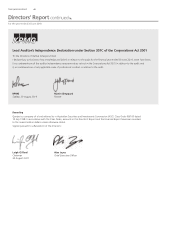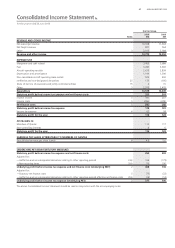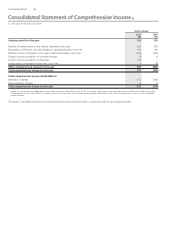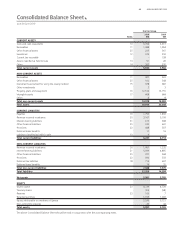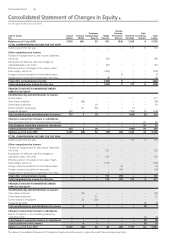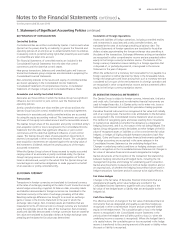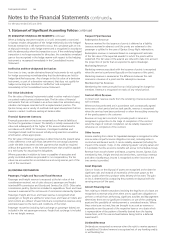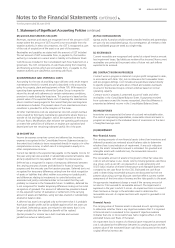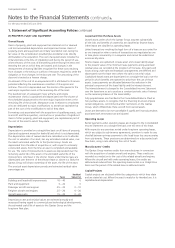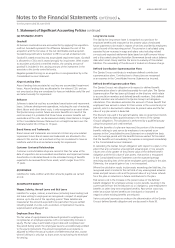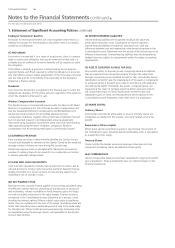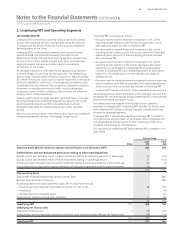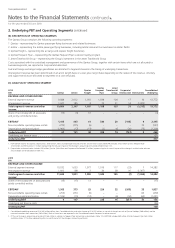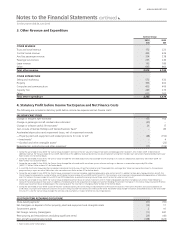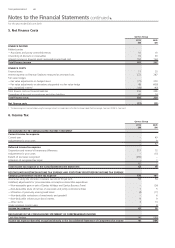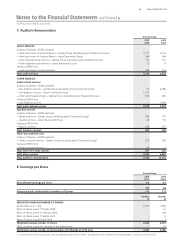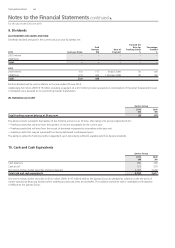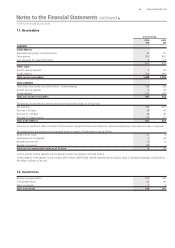Qantas 2010 Annual Report Download - page 57
Download and view the complete annual report
Please find page 57 of the 2010 Qantas annual report below. You can navigate through the pages in the report by either clicking on the pages listed below, or by using the keyword search tool below to find specific information within the annual report.
55 ANNUAL REPORT 2010
for the year ended 30 June 2010
Notes to the Financial Statements continued
(H) GOODS AND SERVICES TAX (GST)
Revenues, expenses and assets are recognised net of the amount of GST,
except where the amount of GST incurred is not recoverable from the
taxation authority. In these circumstances, the GST is recognised as part
of the cost of acquisition of the asset or as part of the expense.
Receivables and payables are stated with the amount of GST included.
The net amount of GST recoverable from, or payable to, the taxation
authority is included as a current asset or liability in the Balance Sheet.
Cash ows are included in the Consolidated Cash Flow Statement on a
gross basis. The GST components of cash ows arising from investing
and nancing activities which are recoverable from, or payable to, the
taxation authority are classi ed as operating cash ows.
(I) MAINTENANCE AND OVERHAUL COSTS
Accounting for the cost of providing major airframe and certain engine
maintenance checks for owned aircraft is described in the accounting
policy for property, plant and equipment in Note 1(P). With respect to
operating lease agreements, where the Qantas Group is required to
return the aircraft with adherence to certain maintenance conditions,
provision is made during the lease term. This provision is based on the
present value of the expected future cost of meeting the maintenance
return condition having regard to the current eet plan and long-term
maintenance schedules. The present value of non-maintenance return
conditions is provided for at the inception of the lease.
All other maintenance costs are expensed as incurred, except overhaul
costs covered by third party maintenance agreements where there is a
transfer of risk and legal obligation, which are expensed on the basis
of hours own. Modi cations that enhance the operating performance
or extend the useful lives of airframes or engines are capitalised and
depreciated over the remaining estimated useful life of the asset.
(J) INCOME TAX
Income tax expense comprises current and deferred tax. Income tax
expense is recognised in the Consolidated Income Statement except to
the extent that it relates to items recognised directly in equity or in other
comprehensive income, in which case it is recognised in equity or in
other comprehensive income.
Current tax liability is the expected tax payable on the taxable income for
the year, using tax rates enacted or substantially enacted at balance date
and any adjustment to tax payable with respect to previous years.
Deferred tax is recognised in respect of temporary differences between
the carrying amounts of assets and liabilities for nancial reporting
purposes and the amounts used for taxation purposes. Deferred tax is not
recognised for temporary differences arising from the initial recognition
of assets or liabilities that affect neither accounting nor taxable pro t,
and differences relating to investments in controlled entities and
associates and jointly controlled entities to the extent that they will
probably not reverse in the foreseeable future. In addition, deferred tax
is not recognised for taxable temporary differences arising on the initial
recognition of goodwill. The amount of deferred tax provided is based
on the expected manner of realisation or settlement of the carrying
amount of assets and liabilities, using tax rates enacted or substantially
enacted at balance date.
A deferred tax asset is recognised only to the extent that it is probable
that future taxable pro ts will be available against which the asset can
be utilised. Deferred tax assets are reduced to the extent that it is no
longer probable that the related tax bene t will be realised.
Qantas provides for income tax in both Australia and overseas
jurisdictions where a liability exists.
(K) TAX CONSOLIDATION
Qantas and its Australian wholly-owned controlled entities and partnerships
are part of a tax consolidated group. As a consequence, all members of the
tax consolidated group are taxed as a single entity.
(L) RECEIVABLES
Current receivables are recognised and carried at original invoice amount
less impairment losses. Bad debts are written off as incurred. Non-current
receivables are carried at the present value of future net cash in ows
expected to be received.
(M) CONTRACT WORK IN PROGRESS
Contract work in progress is stated at cost plus pro t recognised to date,
in accordance with Note 1(G), less an allowance for foreseeable losses
and less progress billings. Cost includes all expenditure related directly
to speci c projects and an allocation of xed and variable overheads
incurred in the Qantas Group’s contract activities based on normal
operating capacity.
Contract work in progress is presented as part of trade and other
receivables in the Consolidated Balance Sheet. If payments received
from customers exceed the income recognised, then the difference is
presented as deferred income in the Consolidated Balance Sheet.
(N) INVENTORIES
Inventories are measured at the lower of cost and net realisable value.
The costs of engineering expendables, consumable stores and work in
progress are assigned to the individual items of inventories on the basis
of weighted average costs.
(O) IMPAIRMENT
Non- nancial Assets
The carrying amounts of non- nancial assets (other than inventories and
deferred tax assets) are reviewed at each balance date to determine
whether there is any indication of impairment. If any such indication
exists, the assets’ recoverable amount is estimated. For goodwill and
intangible assets with inde nite lives, the recoverable amount is
estimated each year.
The recoverable amount of assets is the greater of their fair value less
costs to sell and value in use. Assets which primarily generate cash ows
as a group, such as aircraft, are assessed on a cash generating unit
(CGU) basis inclusive of related infrastructure and intangible assets and
compared to net cash ows for the CGU. Estimated net cash ows
used in determining recoverable amounts are discounted to their net
present value using a pre-tax discount rate that re ects current market
assessments of the time value of money and the risks speci c to the asset.
An appropriate impairment charge is made if the carrying amount of
an asset or CGU exceeds its recoverable amount. The impairment is
expensed in the year in which it occurs. An impairment loss is reversed if
there has been a change in the estimates used to determine the
recoverable amount. An impairment loss with respect to goodwill is not
reversed.
Financial Assets
The carrying value of nancial assets is assessed at each reporting date
to determine whether there is any objective evidence that it is impaired.
A nancial asset is considered to be impaired if objective evidence
indicates that one or more events have had a negative effect on the
estimated future cash ows of that asset.
An impairment loss in respect of a nancial asset measured at amortised
cost is calculated as the difference between its carrying amount and the
present value of the estimated future cash ows discounted at the asset’s
original effective interest rate.
1. Statement of Signi cant Accounting Policies continued


